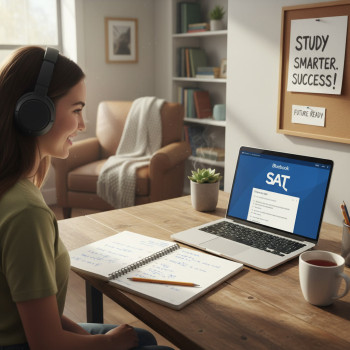Why Colleges Reward SAT Score Improvements (and Why That Matters to You)
There’s something quietly powerful about progress. A higher SAT score doesn’t just open doors in the application process — for many students it also opens wallets. Over the last several years, colleges have increasingly recognized and rewarded demonstrable improvement on standardized tests as a marker of grit, growth, and academic readiness. That trend matters because it gives students (and their families) a second — and sometimes a third — chance to translate effort into financial aid.
If you’re studying for the Digital SAT and hope to attend a top college, knowing which institutions explicitly or implicitly reward improvement can change how you prioritize practice, retakes, and targeted tutoring. Below, we’ll walk through how schools award scholarships for score gains, examples of typical policies, concrete strategies to increase scores strategically, and how to present your story in a way that maximizes both admissions and scholarship potential.

How Colleges Translate Score Improvement Into Scholarships
Not every college publishes a neat “improvement scholarship” policy. But in practice, schools use improved scores in several scholarship-related ways:
- Automatic merit brackets: Many colleges use score bands to determine automatic merit awards. If an improved score moves you into a higher band, you may become eligible for a larger automatic scholarship.
- Superscoring benefits: Some schools superscore the SAT — meaning they combine your best section scores across multiple test dates. If your later test shows stronger sections, your superscore can bump you into scholarship territory.
- Holistic review advantage: Admissions teams often treat improvement as evidence of resilience and academic growth, which can boost chances for need-blind merit awards allocated through holistic review.
- Scholarship competitions and portals: Colleges and third-party scholarship programs sometimes invite applicants who demonstrate improvement to apply to special awards or consideration pools.
Real-World Example: The Power of a 40–80 Point Gain
Imagine two students: Maya scores 1180 and then improves to 1260 after targeted prep; James scores 1300 and stays there. If a college awards meaningful merit at 1250 and again at 1350, Maya’s gain pushed her into a new bracket — unlocking, say, a $6,000 per-year award. That difference can alter net price significantly over four years.
Which Types of Colleges Reward Score Improvements?
While exact policies vary, certain categories of institutions tend to reward score improvements more visibly:
- Mid- to large-sized public and private universities: These schools often have clear merit bands and automatic scholarships tied to test scores. Improving your score can move you into a higher tier.
- Liberal arts colleges with flexible merit budgets: Many smaller colleges use merit aid strategically to attract students who show growth; an improving student signals potential.
- Colleges that superscore: If a school superscores, retaking strategically to strengthen a weaker section can pay off.
- Institutions with outreach programs via college planning platforms: Schools using platforms that partner with students who opt-in (for example, where students share test progress) sometimes notify applicants about targeted scholarships.
How to Find Colleges That Will Reward Your Score Improvement
Start with a mix of research techniques to build a list tailored to your profile and goals:
- Look for published merit charts: Many colleges publish score- or GPA-based merit award schedules. If a school lists awards starting at specific SAT score thresholds, you can calculate what an improvement might earn.
- Check superscoring policies: If a school explicitly superscores, think strategically about retaking to boost your weaker section rather than aiming for a single higher composite.
- Ask admissions or financial aid officers: Email admissions or the scholarship office and ask how improvements or multiple test dates are considered. The answers can be surprisingly practical and specific.
- Use your college planning accounts: If you’re signed up for services that connect students and colleges, you may receive targeted scholarship outreach based on updated scores.
Sample Merit Award Table (Hypothetical — Illustrative Only)
| SAT Score Range | Annual Merit Award | Notes |
|---|---|---|
| 1200–1249 | $3,000 | Automatic for in-state and out-of-state |
| 1250–1299 | $6,000 | Superscoring applies |
| 1300–1349 | $10,000 | Competitive; may require application |
| 1350–1399 | $15,000 | High merit tier — renewable |
Note: The table above is illustrative to show how small score bands can translate into meaningful scholarship amounts. Actual award levels and thresholds differ by college.
Practical Roadmap: Turn Score Improvement Into Scholarship Dollars
Improving your SAT score is both a numbers game and a storytelling opportunity. Here’s a tactical plan you can follow.
1) Audit Your Baseline and Set a Target
Start with your current diagnostic score, then research the schools you want. Identify the score thresholds that unlock the next scholarship tier. Your target should be the lowest score that reliably moves you into more aid — that’s efficient practice.
2) Choose the Right Retake Strategy
Retaking the Digital SAT is not about blind repetition — it’s about targeted improvement.
- If one section (Math or Evidence-Based Reading & Writing) is clearly lower, focus on that section to gain a 30–60 point edge.
- If you’re close to the next merit bracket, prioritize test dates that give you enough time to improve by that margin and meet application deadlines.
- Use superscoring strategically: if your best section scores across dates yield a higher composite, a focused sectional boost can matter more than an all-around increase.
3) Build a Smart Study Plan (Quality Over Quantity)
A regimented, targeted study plan beats sporadic marathon sessions. Focus on these pillars:
- Diagnostic review: Identify question types that cost you points — data interpretation, algebraic structure, command of evidence, or vocabulary-in-context.
- Active practice: Timed sections, then detailed error analysis to avoid repeating mistakes.
- Strategy drills: Pacing, test-taking stamina, and digital interface familiarity (for the Digital SAT) are all testable skills.
- Mock tests: Take full-length practice tests under realistic conditions to map progress.
Sparkl’s personalized tutoring model — with 1-on-1 guidance, tailored study plans, and AI-driven insights — fits neatly here because it helps translate diagnostics into daily actions that produce measurable score gains.
4) Interpret Gains and Recalculate Net Price
When you see improvement, don’t celebrate in isolation. Recalculate the net cost of attendance using the new score: how much more merit aid do you get annually? Multiply by four and compare with the cost of extra tutoring and test registrations. Often, a modest cost for focused help is quickly offset by scholarship gains.
5) Tell the Right Story
When contacting admissions or applying for competitive scholarships, frame improvement as part of a growth narrative. Mention concrete steps you took: targeted tutoring, specific resources, coursework, and the intellectual habits that changed. Admissions officers and scholarship committees value documented progress.
Study Techniques That Yield Real, Measurable Improvement
Not all study is created equal. Below are high-leverage techniques that produce reliable improvements on the Digital SAT.
- Error log: Keep a running list of every question you miss, why you missed it, and the exact strategy to avoid it next time.
- Short, focused practice cycles: 25–40 minute focused study blocks with a single objective (e.g., linear equations, command of evidence) beat unfocused hours.
- Backward mastery: Start with harder problems in a category to quickly reveal gaps; then master easier items to cement skills.
- Digital comfort: Familiarize yourself with the Digital SAT interface — practice navigating tools, annotations, and time management onscreen.
- Data-driven adjustments: Use practice test diagnostics to reallocate study time. If your reading comprehension percentiles surge while math lags, shift focus accordingly.
How Parents Can Support Without Taking Over
Parents play a crucial role in sustaining momentum. The key is supportive structure rather than pressure.
- Set a predictable routine: Consistent study windows reduce stress and build habit.
- Celebrate process wins: Praise consistent practice and improvements in weaker areas, not just the final score.
- Invest smartly: Consider targeted tutoring or a short, intensive program when a student stalls — a focused investment can pay dividends in scholarships.
- Help manage deadlines: Keep track of test dates, registration deadlines, and the application timelines for schools where a score bump could change aid offers.
Timing: When to Retake the Digital SAT
Timing matters. Retake with enough runway for improvement and to meet application timelines. A typical timeline looks like this:
- Junior year spring: initial full-length diagnostic and first serious prep cycle.
- Summer between junior and senior year: intensive targeted reviews and first retake (if ready).
- Early fall senior year: final retake to capture gains before early-action or early-decision deadlines.
Always check individual college application deadlines and scholarship calendars — if a school requires scores by an early deadline, your retake strategy must accommodate that date.
Money Math: How Small Gains Yield Big Returns
Understanding the math motivates deliberate effort. Consider a hypothetical example:
- An improvement of 40–60 points moves a student from a $3,000/year award to a $6,000/year award → $12,000 difference over four years.
- A strategic 100-point gain could shift a student into a top merit tier worth $10,000–$20,000/year → $40,000–$80,000 over four years.
When you weigh these numbers against the cost of a few months of focused tutoring or an extra test fee, the return on investment for targeted improvement is often compelling.
How to Document and Present Improvement in Applications
If you’ve improved meaningfully, highlight it thoughtfully:
- Brief mention in the application or additional info: A short note about your SAT growth and the deliberate steps you took can frame your score in a positive light.
- Recommendation letters: If a teacher or counselor can speak to your academic growth or study habits, that reinforces the signal of improvement.
- Scholarship essays: For competitive awards, use your essay to show how you identified weaknesses, sought resources, and improved through perseverance.

When to Consider Paid, Personalized Help
Everyone’s trajectory is different. Some students make steady progress with solo practice; others hit plateaus. Consider investing in personalized tutoring when:
- You’ve plateaued after multiple timed practice tests.
- You need targeted sectional improvement to reach the next scholarship bracket.
- Your schedule requires an efficient, tailored plan rather than trial-and-error practice.
Personalized 1-on-1 tutoring — like Sparkl’s approach with tailored study plans, expert tutors, and AI-driven insights — can accelerate progress by focusing on the precise question types and habits that cost you points. For families weighing cost, run the numbers: if a short tutoring program propels a student into a higher merit tier, the scholarship often pays back the investment many times over.
Common Pitfalls That Waste Effort
Watch out for these traps:
- Broad, unfocused studying: Hours without error analysis rarely produce reliable gains.
- Chasing perfection: Trying to gain 200+ points quickly is often unrealistic; target the specific increment that yields more aid.
- Ignoring digital interface practice: The Digital SAT’s testing environment requires particular comfort with the test platform.
- Missing deadlines: A higher score is only useful if it arrives before the scholarship or application deadline.
Putting It All Together: A 12-Week Improvement Plan
This condensed plan is designed to generate meaningful, scholarship-relevant gains by focusing on diagnostics, deliberate practice, and strategic retakes.
- Weeks 1–2: Full diagnostic; create error log; set target based on college merit thresholds.
- Weeks 3–6: Focused skill blocks (two per week: one math, one evidence-based), short timed sections, and weekly tutor or mentor check-ins.
- Week 7: Full-length practice under realistic conditions; analyze results and refine plan.
- Weeks 8–10: Targeted drills to shore up weak areas revealed by practice test; pacing work and digital practice platform familiarity.
- Week 11: Final review, light practice, and mental preparation strategies (sleep, nutrition, pacing). Register for test if gains look likely.
- Week 12: Test day or final full-length practice if waiting for application deadlines permits another retake.
Final Thoughts: Improvement Is Scholarship Leverage
Too often, students treat the SAT as a single gate to cross. The smarter play is to treat it like a process — one in which measurable improvement is both evidence of growth and a lever for financial aid. With deliberate planning, targeted practice, and the occasional boost from 1-on-1 tutoring, you can transform incremental gains into meaningful scholarship dollars.
Remember: small, focused improvements often beat unfocused leaps. If improving your score by 30–60 points gets you a higher merit bracket or a more competitive standing for scholarship pools, that’s where to put your energy. And if you need help translating diagnostics into action, personalized tutoring — such as Sparkl’s tailored study plans, expert tutors, and AI-driven insights — can make the path shorter and more predictable.
Quick Checklist: Steps to Turn SAT Gains Into Scholarships
- Identify scholarship thresholds for target colleges.
- Set a realistic, scholarship-focused score goal.
- Build a diagnostic-driven study plan with short, focused sessions.
- Consider targeted 1-on-1 tutoring to break plateaus.
- Time your retakes to meet scholarship and application deadlines.
- Document your improvement and use it in applications or scholarship essays.
Your Next Step
Start by running a diagnostic test this week and mapping the score thresholds for three colleges you’d love to attend. If you’re within reach of a higher merit tier, build a 6–12 week plan focused on the precise sections that matter. With careful strategy, steady work, and the right support, your score improvements can become real scholarship dollars — and that’s a concrete way your hard work today pays off tomorrow.
Good luck, and remember: steady, strategic progress often wins the prize. If you want help designing a personalized plan — including one tailored to the Digital SAT format — consider exploring options that offer 1-on-1 guidance, tailored study plans, and AI-driven insights to accelerate your gains and maximize scholarship opportunity.













No Comments
Leave a comment Cancel